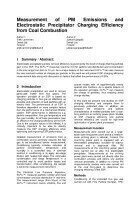Air monitoring
Measurement of PM Emissions and Electrostatic Precipitator Charging Efficiency from Coal Combustion
Dec 12 2014
Author: Erkki Lamminen, Jukka Kujanpää on behalf of CEM
Summary / Abstract
Electrostatic precipitator particle removal efficiency is governed by the level of charge that the particles gain in the ESP. The ELPI+™ measures real-time (10 Hz) particle size distribution and concentration in the size range from 6nm to 10 μm. As a unique feature of the instrument ELPI+™ can also measure
the size resolved number of charges per particle. In this work we will present ESP charging efficiency measurement data along with discussion on factors that affect the performance of ESPs.
Introduction
Electrostatic precipitators are used to remove particulate matter from flue gases. The operation principle of an ESP is based on charging particles in flue gas as effectively as possible and collection of said particles with an electric field. The performance of an ESP is therefore dependent on more complex factors than the performance of a mechanical filtration system. ESP performance is affected by e.g. particle composition, flue gas temperature and flue gas humidity. All of these parameters have an effect on the charging efficiency of the ESP. Due to the complex nature of the effects, it is critically important to be able to directly measure the ESP charging efficiency when optimizing and improving ESP performance. Detailed measurement of emissions from a combustion source generally requires the flue gas to be conditioned before measurement. Conditioning typically includes reduction of particle concentration, temperature and humidity in a controlled way. A common method in conditioning is to apply two-stage dilution with heated first stage. This eliminates condensation and drops temperature in a controlled way to avoid particle losses and transformation. After conditioning, the sample is led to the measurement instrument. The Electrical Low Pressure Impactor+, ELPI+™, measures particle number and mass concentration and size distribution in real-time. The measurement range (6nm-10μm) of the ELPI+™ instrument covers ultrafine, fine and coarse modes with 14 logarithmically evenly spaced size fractions. As a special feature of the operation principle, ELPI+™ can measure the charge of particles, thus enabling direct charge studies. In this work we present new studies on ESP charging efficiency and compare them to previously published data. In addition, we compare the emissions and particle characteristics of emitted particles from a coalfiring and from an oil-firing power plant. Studies of ESP charging efficiency and particle removal efficiency are crucial for high-level optimization of power plant processes.
Digital Edition
IET 35.2 March
April 2025
Air Monitoring - Probe Sampling in Hazardous Areas Under Extreme Conditions - New, Game-Changing Sensor for Methane Emissions - Blue Sky Thinking: a 50-year Retrospective on Technological Prog...
View all digital editions
Events
Apr 08 2025 Birmingham, UK
Apr 08 2025 Targi Kielce, Poland
Apr 08 2025 Baku, Azerbaijan
Apr 08 2025 Bahrain
Apr 10 2025 Beijing, China















